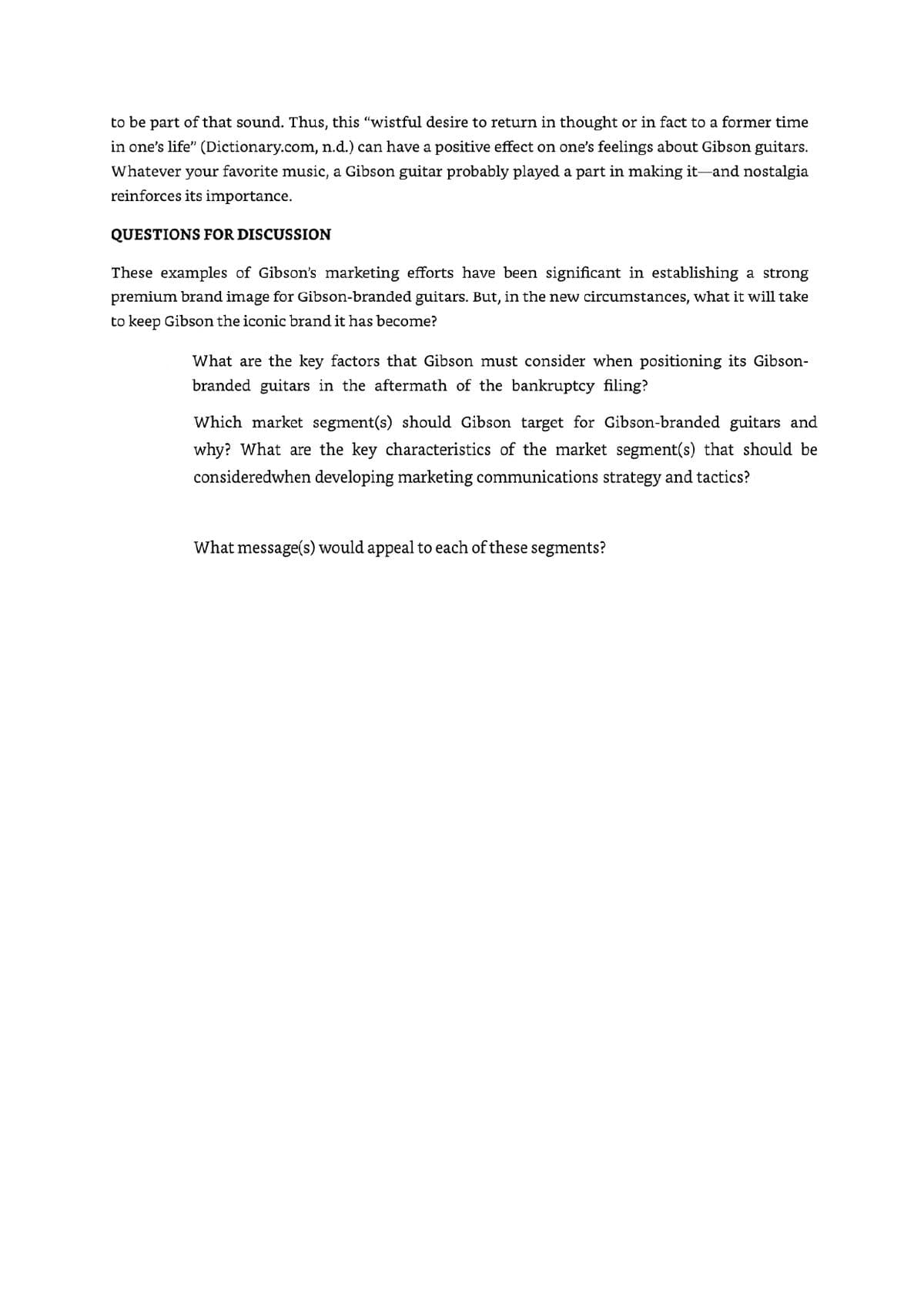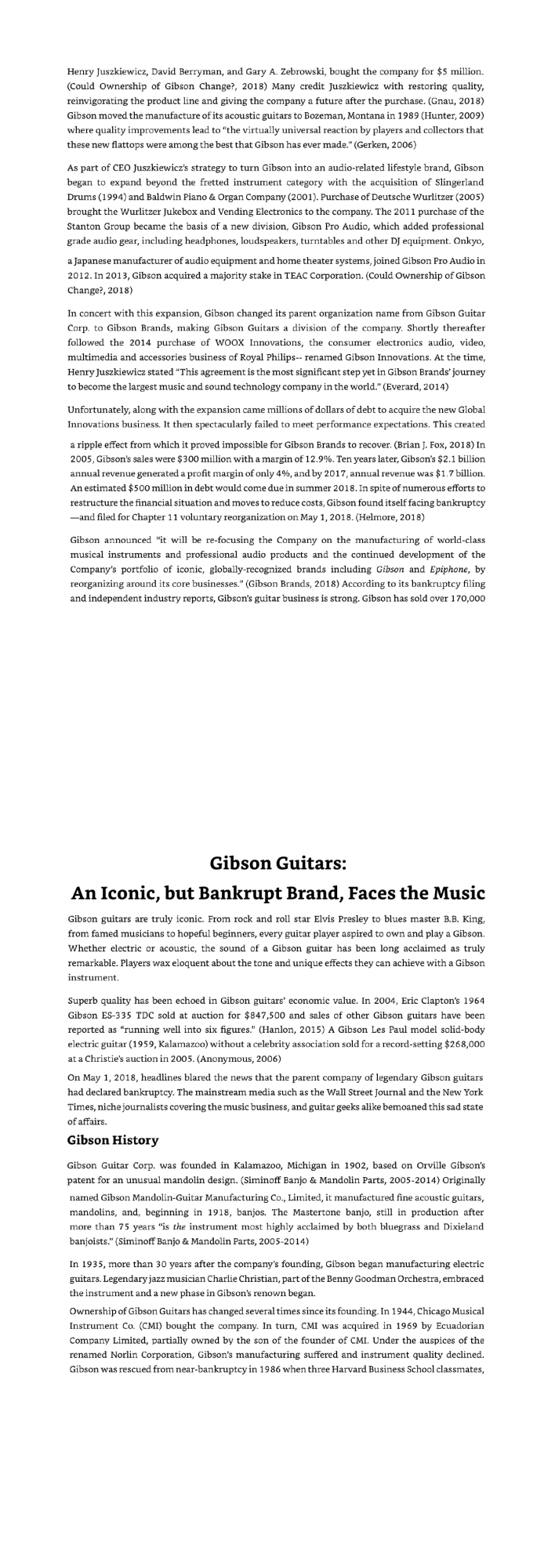QUESTIONS FOR DISCUSSION These examples of Gibson's marketing efforts have been significant in establishing a strong premium brand image for Gibson-branded guitars. But, in the new circumstances, what it will take to keep Gibson the iconic brand it has become? What are the key factors that Gibson must consider when positioning its Gibson- branded guitars in the aftermath of the bankruptcy filing? Which market segment(s) should Gibson target for Gibson-branded guitars and why? What are the key characteristics of the market segment(s) that should be consideredwhen developing marketing communications strategy and tactics?
QUESTIONS FOR DISCUSSION These examples of Gibson's marketing efforts have been significant in establishing a strong premium brand image for Gibson-branded guitars. But, in the new circumstances, what it will take to keep Gibson the iconic brand it has become? What are the key factors that Gibson must consider when positioning its Gibson- branded guitars in the aftermath of the bankruptcy filing? Which market segment(s) should Gibson target for Gibson-branded guitars and why? What are the key characteristics of the market segment(s) that should be consideredwhen developing marketing communications strategy and tactics?
Principles Of Marketing
17th Edition
ISBN:9780134492513
Author:Kotler, Philip, Armstrong, Gary (gary M.)
Publisher:Kotler, Philip, Armstrong, Gary (gary M.)
Chapter1: Marketing: Creating Customer Value And Engagement
Section: Chapter Questions
Problem 1.1DQ
Related questions
Question

Transcribed Image Text:to be part of that sound. Thus, this "wistful desire to return in thought or in fact to a former time
in one's life" (Dictionary.com, n.d.) can have a positive effect on one's feelings about Gibson guitars.
Whatever your favorite music, a Gibson guitar probably played a part in making it and nostalgia
reinforces its importance.
QUESTIONS FOR DISCUSSION
These examples of Gibson's marketing efforts have been significant in establishing a strong
premium brand image for Gibson-branded guitars. But, in the new circumstances, what it will take
to keep Gibson the iconic brand it has become?
What are the key factors that Gibson must consider when positioning its Gibson-
branded guitars in the aftermath of the bankruptcy filing?
Which market segment(s) should Gibson target for Gibson-branded guitars and
why? What are the key characteristics of the market segment(s) that should be
consideredwhen developing marketing communications strategy and tactics?
What message(s) would appeal to each of these segments?

Transcribed Image Text:Henry Juszkiewicz, David Berryman, and Gary A. Zebrowski, bought the company for $5 million.
(Could Ownership of Gibson Change?, 2018) Many credit Juszkiewicz with restoring quality,
reinvigorating the product line and giving the company a future after the purchase. (Gnau, 2018)
Gibson moved the manufacture of its acoustic guitars to Bozeman, Montana in 1989 (Hunter, 2009)
where quality improvements lead to "the virtually universal reaction by players and collectors that
these new flattops were among the best that Gibson has ever made." (Gerken, 2006)
As part of CEO Juszkiewicz's strategy to turn Gibson into an audio-related lifestyle brand, Gibson
began to expand beyond the fretted instrument category with the acquisition of Slingerland
Drums (1994) and Baldwin Piano & Organ Company (2001). Purchase of Deutsche Wurlitzer (2005)
brought the Wurlitzer Jukebox and Vending Electronics to the company. The 2011 purchase of the
Stanton Group became the basis of a new division, Gibson Pro Audio, which added professional
grade audio gear, including headphones, loudspeakers, turntables and other DJ equipment. Onkyo,
a Japanese manufacturer of audio equipment and home theater systems, joined Gibson Pro Audio in
2012. In 2013, Gibson acquired a majority stake in TEAC Corporation. (Could Ownership of Gibson
Change?, 2018)
In concert with this expansion, Gibson changed its parent organization name from Gibson Guitar
Corp. to Gibson Brands, making Gibson Guitars a division of the company. Shortly thereafter
followed the 2014 purchase of WOOX Innovations, the consumer electronics audio, video,
multimedia and accessories business of Royal Philips-- renamed Gibson Innovations. At the time,
Henry Juszkiewicz stated "This agreement is the most significant step yet in Gibson Brands' journey
to become the largest music and sound technology company in the world." (Everard, 2014)
Unfortunately, along with the expansion came millions of dollars of debt to acquire the new Global
Innovations business. It then spectacularly failed to meet performance expectations. This created
a ripple effect from which it proved impossible for Gibson Brands to recover. (Brian J. Fox, 2018) In
2005, Gibson's sales were $300 million with a margin of 12.9%. Ten years later, Gibson's $2.1 billion
annual revenue generated a profit margin of only 4%, and by 2017, annual revenue was $1.7 billion.
An estimated $500 million in debt would come due in summer 2018. In spite of numerous efforts to
restructure the financial situation and moves to reduce costs, Gibson found itself facing bankruptcy
--and filed for Chapter 11 voluntary reorganization on May 1, 2018. (Helmore, 2018)
Gibson announced "it will be re-focusing the Company on the manufacturing of world-class
musical instruments and professional audio products and the continued development of the
Company's portfolio of iconic, globally-recognized brands including Gibson and Epiphone, by
reorganizing around its core businesses." (Gibson Brands, 2018) According to its bankruptcy filing
and independent industry reports, Gibson's guitar business is strong. Gibson has sold over 170,000
Gibson Guitars:
An Iconic, but Bankrupt Brand, Faces the Music
Gibson guitars are truly iconic. From rock and roll star Elvis Presley to blues master B.B. King,
from famed musicians to hopeful beginners, every guitar player aspired to own and play a Gibson.
Whether electric or acoustic, the sound of a Gibson guitar has been long acclaimed as truly
remarkable. Players wax eloquent about the tone and unique effects they can achieve with a Gibson
instrument.
Superb quality has been echoed in Gibson guitars' economic value. In 2004, Eric Clapton's 1964
Gibson ES-335 TDC sold at auction for $847,500 and sales of other Gibson guitars have been
reported as "running well into six figures." (Hanlon, 2015) A Gibson Les Paul model solid-body
electric guitar (1959, Kalamazoo) without a celebrity association sold for a record-setting $268,000
at a Christie's auction in 2005. (Anonymous, 2006)
On May 1, 2018, headlines blared the news that the parent company of legendary Gibson guitars
had declared bankruptcy. The mainstream media such as the Wall Street Journal and the New York
Times, niche journalists covering the music business, and guitar geeks alike bemoaned this sad state
of affairs.
Gibson History
Gibson Guitar Corp. was founded in Kalamazoo, Michigan in 1902, based on Orville Gibson's
patent for an unusual mandolin design. (Siminoff Banjo & Mandolin Parts, 2005-2014) Originally
named Gibson Mandolin-Guitar Manufacturing Co., Limited, it manufactured fine acoustic guitars,
mandolins, and, beginning in 1918, banjos. The Mastertone banjo, still in production after
more than 75 years "is the instrument most highly acclaimed by both bluegrass and Dixieland
banjoists." (Siminoff Banjo & Mandolin Parts, 2005-2014)
In 1935, more than 30 years after the company's founding, Gibson began manufacturing electric
guitars. Legendary jazz musician Charlie Christian, part of the Benny Goodman Orchestra, embraced
the instrument and a new phase in Gibson's renown began.
Ownership of Gibson Guitars has changed several times since its founding. In 1944, Chicago Musical
Instrument Co. (CMI) bought the company. In turn, CMI was acquired in 1969 by Ecuadorian
Company Limited, partially owned by the son of the founder of CMI. Under the auspices of the
renamed Norlin Corporation, Gibson's manufacturing suffered and instrument quality declined.
Gibson was rescued from near-bankruptcy in 1986 when three Harvard Business School classmates,
Expert Solution
This question has been solved!
Explore an expertly crafted, step-by-step solution for a thorough understanding of key concepts.
This is a popular solution!
Trending now
This is a popular solution!
Step by step
Solved in 3 steps

Recommended textbooks for you

Principles Of Marketing
Marketing
ISBN:
9780134492513
Author:
Kotler, Philip, Armstrong, Gary (gary M.)
Publisher:
Pearson Higher Education,

Marketing
Marketing
ISBN:
9781259924040
Author:
Roger A. Kerin, Steven W. Hartley
Publisher:
McGraw-Hill Education

Foundations of Business (MindTap Course List)
Marketing
ISBN:
9781337386920
Author:
William M. Pride, Robert J. Hughes, Jack R. Kapoor
Publisher:
Cengage Learning

Principles Of Marketing
Marketing
ISBN:
9780134492513
Author:
Kotler, Philip, Armstrong, Gary (gary M.)
Publisher:
Pearson Higher Education,

Marketing
Marketing
ISBN:
9781259924040
Author:
Roger A. Kerin, Steven W. Hartley
Publisher:
McGraw-Hill Education

Foundations of Business (MindTap Course List)
Marketing
ISBN:
9781337386920
Author:
William M. Pride, Robert J. Hughes, Jack R. Kapoor
Publisher:
Cengage Learning

Marketing: An Introduction (13th Edition)
Marketing
ISBN:
9780134149530
Author:
Gary Armstrong, Philip Kotler
Publisher:
PEARSON


Contemporary Marketing
Marketing
ISBN:
9780357033777
Author:
Louis E. Boone, David L. Kurtz
Publisher:
Cengage Learning